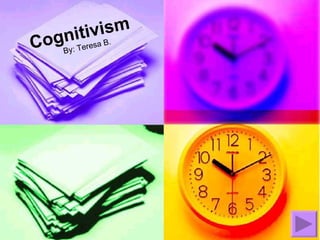
Teresa B. - Cognitivism
- 1. vism gniti . Co By: Teres aB
- 2. Overview Description of the Cognitivism Theory Key points of Cognitivism Key people associated with Cognitivism Benjamin Bloom Classroom implications of the theory
- 3. Cognitivism - What is it? In the 1960’s the cognitive revolution came along and replaced behaviorism as the dominant paradigm. The theory of cognitivism focuses on the inner mental activities – opening the “black box” of the human mind is vital in understanding how people learn. According to the cognitive school of thought, mental processes such as thinking, memory, and problem-solving need to be explored.
- 4. Cognitivism Explained Cognitivism is a theory which attempts to answer how and why people learn by attributing the process to cognitive activity. This theory originally followed the behaviorist school of thought. The cognitivists’ quarrel with the behaviorists was that their focus on observable behavior did not account for what was going on in the mind.
- 5. Key Points Of Cognitivism Cognitivism is based on the thought process behind the behavior. Changes in behavior are observed, and used as indicators as to what is happening inside the learner's mind. Mental processes such as thinking, memory, knowing, and problem-solving need to be explored.
- 6. Key Points Of Cognitivism continued: The cognitivist paradigm states that the “black box” of the mind should be opened and understood. The learner is viewed as an information processor (like a computer). Cognitivism uses the metaphor of the mind as a computer: information comes in, becomes processed, and leads to certain outcomes.
- 7. Contributors to Cognitivism continued: These are the theorists that developed and advocated for cognitivism: R.C. Anderson developed a schema of learning. His theory attempted to describe learning as the storing of information by the human mind in structures of ideas and meanings. Benjamin Bloom described six levels of learning in his model of critical thinking otherwise known as “Bloom’s Taxonomy.”
- 8. Contributors to Cognitivism continued: These are the theorists that developed and advocated for cognitivism: Robert Gagne identified 5 major categories of learning and 9 events of instruction. Kurt Lewin developed field theory, which states that human behavior is the function of both the person and the environment.
- 9. Benjamin Bloom Bloom’s Taxonomy A practical way of classifying curriculum goals and objectives. Bloom identified six levels in the cognitive domain: Knowledge Comprehension Application Analysis Synthesis Evaluation
- 10. Classroom Implications: What the teacher does under this theory without technology: Visual aids (such as posters) can be used to reinforce concepts. Encourage students to form visual images that capture the things they are studying. Instructional materials should include demonstration, illustrative examples and constructive feedback.
- 11. Classroom Implications: What the teacher does under this theory with technology: Teachers can present their lecture material via visual and/or audio format. For example: PowerPoint or Prezi Organized instruction can be provided through the use of concept maps. The SMART board is a way for the teacher to incorporate technology into the classroom. For example: spelling words can be written on the board and the students can follow along by utilizing the animated technology.
- 12. Classroom Implications: What the student does under this theory without technology: Use flashcards, note cards and/or written notes to assist with recall of the subject matter. Students can participate in open discussions that involve critical thinking questions and ideas. When working in group projects, students can use a display board to showcase the results of the group effort.
- 13. Classroom Implications: What the student does under this theory with technology: Students can use the internet to research information for homework and school projects. Online programs can be utilized to connect with other students outside of the classroom. Example: Working on group projects via Skype, Facebook, Twitter Students can use programs such as PowerPoint and Prezi to assist in assembling multimedia presentations.
- 14. Cognitivism in the Classroom The Cognitivism Theory would work well for me in the classroom because: Interactive tools can be used to engage students and keep them interested in the subject matter being presented. Students develop critical thinking skills by engaging in a process of looking at a problem, working through the problem, and coming up with the solution.
- 15. Cognitivism in the Classroom continued: The Cognitivism Theory would work well for me in the classroom because: This theory helps teachers recognize the individual differences in their students by merging new knowledge with the old knowledge they already possess. The teacher plays a significant role in this theory. Once the teacher knows the individual strengths and weaknesses of a student, tactics can be devised to increase the possibility of success for that learner.
- 16. References "Benjamin Bloom - Critical Thinking Skills." Inventors. Web. 04 Apr. 2012. <http://inventors.about.com/library/lessons/bl_benja min_bloom.htm>. "Cognitivism." Learning Theories. Web. 01 Apr. 2012. <http://www.learning-theories.com/cognitivism.html>. "Conditions of Learning (Robert Gagne)." Conditions of Learning. Web. 04 Apr. 2012. <http://www.instructionaldesign.org/theories/conditi ons-learning.html>.
- 17. References Culatta, Richard. "Cognitivism Activities." Innovative Learning. Web. 01 Apr. 2012. <http://www.innovativelearning.com/educational_psyc hology/cognitivism/activities.html>. "Kurt Lewin (1890-1947)." Performance Juxtaposition. A Big Dog, Little Dog and Knowledge Jump, 27 Sept. 2010. Web. 04 Apr. 2012. <http://www.nwlink.com/~donclark/hrd/history/lewin. html>. Jorda, Mary, and Suzanne Campbell. "Cognitivism: A Theory of Learning." Florida Atlantic University College of Education. Web. 01 Apr. 2012. <http://www.coe.fau.edu/faculty/cafolla/courses/eme 6051/Cognitivism.htm>.
- 18. References Mergel, Brenda. "Instructional Design & Learning Theory." Learning Theories of Instructional Design. Web. 01 Apr. 2012. <http://www.usask.ca/education/coursework/802papers /mergel/brenda.htm>. "Schema Theory of Learning." SIL International: Partners in Language Development. Web. 01 Apr. 2012. <http://www.sil.org/lingualinks/literacy/ImplementALit eracyProgram/SchemaTheoryofLearning.htm>. Shelly, Gary B., Glenda A. Gunter, and Randolph E. Gunter. Teachers Discovering Computers: Integrating Technology in a Connected World. Boston, MA: Course Technology Cengage Learning, 2012. 257-66. Print